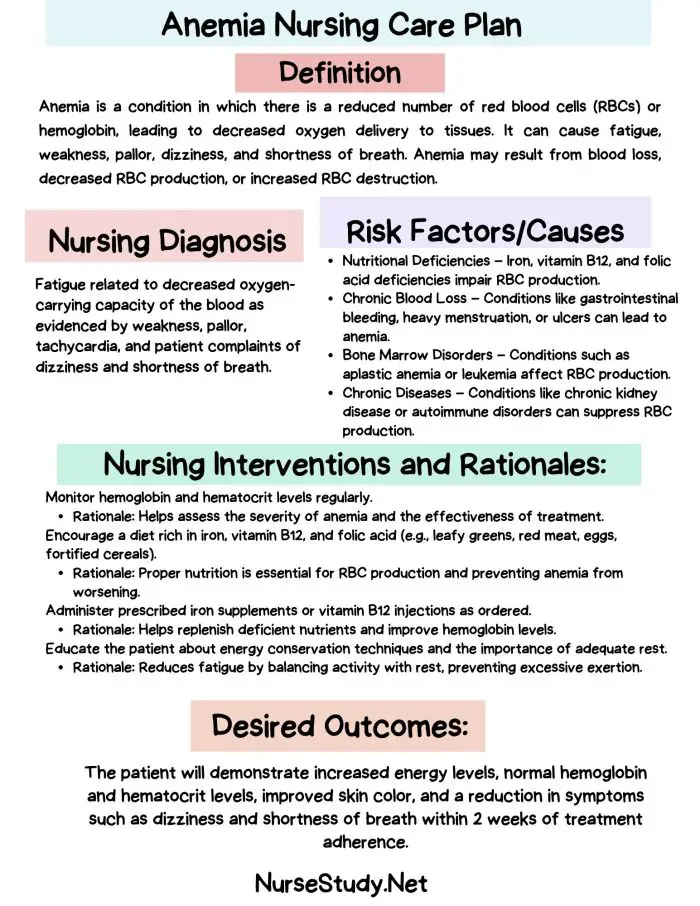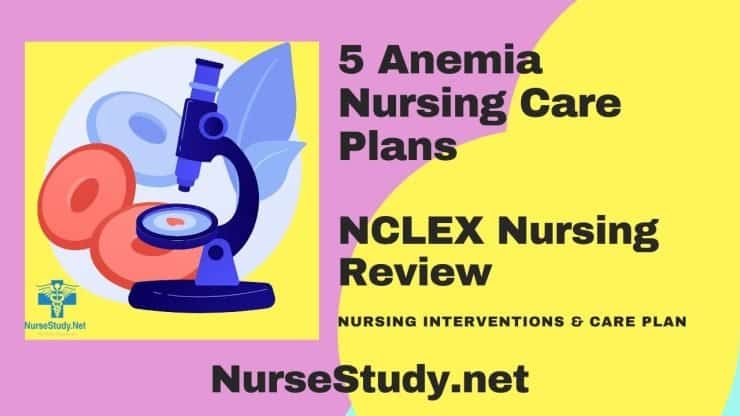Anemia is a condition characterized by a deficiency of red blood cells or hemoglobin in the blood, leading to reduced oxygen transport. This condition is common among patients in various healthcare settings and can result from several underlying causes, including nutritional deficiencies, chronic diseases, or genetic disorders.
Understanding the nursing diagnosis for anemia is essential for providing effective care and promoting recovery.
Nursing Diagnosis for Anemia
A nursing diagnosis for anemia focuses on identifying how the patient’s condition impacts their oxygenation, activity tolerance, and overall health. Common nursing diagnoses associated with anemia include:
- Activity Intolerance related to decreased oxygen-carrying capacity of the blood.
- Fatigue related to inadequate oxygenation of tissues.
- Impaired Gas Exchange related to altered red blood cell count.
- Risk for Ineffective Tissue Perfusion related to a reduction in hemoglobin and hematocrit levels.
Common Symptoms of Anemia
Patients with anemia often present with the following signs and symptoms:
- Fatigue: Due to decreased oxygen delivery to tissues.
- Pallor: A lack of healthy red blood cells can result in a pale appearance, particularly noticeable in mucous membranes.
- Shortness of Breath: This symptom occurs because the body attempts to compensate for reduced oxygen levels.
- Dizziness or Lightheadedness: Caused by insufficient oxygen to the brain.
- Tachycardia: An increased heart rate is a compensatory mechanism to enhance oxygen delivery.
Nursing Care Plan for Anemia
1. Assessment
- Monitor Vital Signs: Pay close attention to heart rate, blood pressure, and oxygen saturation to assess the severity of the anemia.
- Evaluate Laboratory Results: Hemoglobin, hematocrit, and red blood cell indices (MCV, MCH, MCHC) provide critical information on the type and severity of anemia.
- Physical Assessment: Observe the patient for pallor, fatigue, and signs of hypoxia. Auscultate lung sounds for crackles or abnormal findings that may indicate heart failure secondary to severe anemia.
2. Nursing Interventions
- Promote Energy Conservation: Encourage rest periods and advise patients to perform activities slowly to prevent exacerbation of symptoms like fatigue or shortness of breath.
- Administer Oxygen as Prescribed: In cases of severe anemia, supplemental oxygen can help improve tissue oxygenation.
- Ensure Adequate Nutritional Intake: Encourage a diet rich in iron, folic acid, and vitamin B12, which are essential for red blood cell production. Examples include green leafy vegetables, lean meats, and fortified cereals.
- Administer Medications: As prescribed, medications such as iron supplements, vitamin B12 injections, or erythropoiesis-stimulating agents may be necessary depending on the type of anemia.
- Monitor for Complications: Watch for signs of heart failure, such as dyspnea, peripheral edema, and crackles in the lungs, particularly in patients with chronic or severe anemia.
3. Education and Health Promotion
- Educate the Patient on Medication Adherence: Explain the importance of taking iron supplements or other prescribed treatments as directed. Stress that these medications can take time to improve hemoglobin levels.
- Promote Dietary Modifications: Educate the patient on consuming foods high in iron and vitamin C to enhance absorption.
- Encourage Follow-up Appointments: Ensure that the patient understands the importance of regular follow-up visits to monitor hemoglobin levels and overall health.
Expected Outcomes
- The patient will verbalize understanding of the disease process and interventions to manage anemia.
- Hemoglobin and hematocrit levels will improve, indicating effective treatment.
- The patient will report a decrease in fatigue and demonstrate increased activity tolerance.
Evidence-Based Interventions
Interventions for anemia should be based on the underlying cause and severity. For instance, iron deficiency anemia is treated with iron supplementation, while anemia of chronic disease may require more complex management, including addressing the underlying condition. Blood transfusions may be necessary in severe cases.
- Iron Supplementation
Studies have shown that oral iron therapy significantly improves hemoglobin levels in patients with iron-deficiency anemia . Iron absorption is enhanced when taken with vitamin C-rich foods. - Erythropoietin Therapy
In patients with anemia due to chronic kidney disease or chemotherapy, erythropoietin-stimulating agents have been proven to increase red blood cell production and improve oxygen transport . - Folate and Vitamin B12
A deficiency in folate or vitamin B12 leads to megaloblastic anemia, which is commonly treated with supplementation. Studies confirm that early supplementation can reverse hematologic abnormalities .
References
- Mayo Clinic. (2022). Iron deficiency anemia – Diagnosis and treatment. Retrieved from https://www.mayoclinic.org
- National Kidney Foundation. (2023). Erythropoietin Therapy for Anemia. Retrieved from https://www.kidney.org
- American Society of Hematology. (2021). Anemia of Folate Deficiency. Retrieved from https://www.hematology.org

